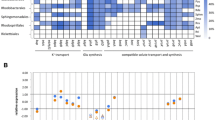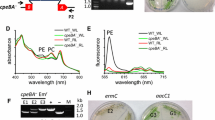Abstract
Energy metabolism and photosynthetic pigment accumulation are affected by salt stress in cyanobacteria leading to cessation of growth. In this study, the effect of salinity on the freshwater cyanobacterium, Fremyella diplosiphon, was investigated and mutagenesis-based efforts were undertaken to enhance salt tolerance. Salinity at a concentration of 10 g/L sodium chloride (NaCl) inhibited growth of wild type F. diplosiphon under white, red, and green light. Efforts to enhance halotolerance resulted in a mutant that could survive in 20 g/L NaCl for 15 generations with no significant reduction in phycobiliproteins (phycocyanin, phycoerythrin, and allophycocyanin) or chlorophyll a. Gene expression measured by quantitative reverse transcription-polymerase chain reaction revealed a three-fold increase in tripartite ATP-independent periplasmic transporters (TRAP) solute receptor transcript in the mutant compared to wild type. Our discovery of a TRAP transporter system in F. diplosiphon and its possible role in salinity response enables growth in brackish waters, which enhances its potential for biotechnological applications.




Similar content being viewed by others
References
Allakhverdiev SI (2002) Salt stress inhibits the repair of photodamaged photosystem II by suppressing the transcription and translation of psbA genes in Synechocystis. Plant Physiol 130:1443–1453
Allakhverdiev SI, Sakamoto A, Nishiyama Y, Inaba M, Murata N (2000) Ionic osmotic effects of NaCl-induced inactivation of photosystems I and II in Synechococcus sp. Plant Physiol 123:1047–1056
Allen M (1968) Simple conditions for growth of unicellular blue-green algae on plates. J Phycol 4:1–4
Berntsson RPA, Smits SH, Schmitt L, Slotboom DJ, Poolman B (2010) A structural classification of substrate-binding proteins. FEBS Lett 584:2606–2617
Clarke A, Eriksson M (2000) The truncated form of the bacterial heat shock protein ClpB/HSP100 contributes to development of thermotolerance in the cyanobacterium Synechococcus sp. Strain PCC 7942. J Bacteriol 182:7092–7096
Cobley JG, Zerweck E, Reyes R, Mody A, Seludo-Unson JR, Jaeger H, Weerasuriya S, Navankasattusas S (1993) Construction of shuttle plasmids which can be efficiently mobilized from Escherichia coli into the chromatically adapting cyanobacterium Fremyella diplosiphon. Plasmid 30:90–105
Dubinsky Z, Stambler N (2009) Photoacclimation processes in phytoplankton: mechanisms, consequences, and applications. Aquat Microb Ecol 56:163–176
Ducat DC, Way JC, Silver PA (2011) Engineering cyanobacteria to generate high-value products. Trends Biotechnol 29:95–103
Ennis DG (2001) Mutagenesis. Encycl Life Sci 1–8
Grammann K, Volke A, Kunte H (2002) New type of osmoregulated solute transporter identified in halophilic members of the bacteria domain: TRAP transporter TeaABC mediates uptake of ectoine and hydroxyectoine in Halomonas elongata DSM 2581T. J Bacteriol 184:3078–3085
Howes NC, FitzGerald DM, Hughes ZJ, Georgiou IY, Kulp MA, Miner MD, Smith JM, Barras JA (2010) Hurricane-induced failure of low salinity wetlands. Proc Natl Acad Sci USA 107:14014–14019
Kahn K, Mazel D, Houmard J, Tandeau de Marsac N, Schaefer M (1997) A role for cpeYZ in cyanobacterial phycoerythrin biosynthesis. J Bacteriol 179:998–1006
Koskinen S, Hakkila K, Gunnelius L, Kurkela J, Wada H, Tyystjärvi T (2015) In vivo recruitment analysis and a mutant strain without any group 2 σ factor reveal roles of different σ factors in cyanobacteria. Mol Microbiol 99:43–54
Kuhlmann SI, Terwisscha van Scheltinga AC, Bienert R, Kunte HJ, Ziegler C (2008) 1.55 Å structure of the ectoine binding protein TeaA of the osmoregulated TRAP-transporter TeaABC from Halomonas elongate. Biochem 47:9475–9485
Laloknam S, Tanaka K, Buaboocha T, Waditee R, Incharoensakdi A, Hibino T, Tanaka Y, Takabe T (2006) Halotolerant cyanobacterium Aphanothece halophytica contains a betaine transporter active at alkaline pH and high salinity. Appl Environ Microbiol 72:6018–6026
Matsunaga T, Takeyama H, Miyashita H, Yokouchi H (2005) Marine Microalgae. Adv Biochem, Eng/Biotech 96:165–188
Montgomery BL (2007) Sensing the light: photoreceptive systems and signal transduction in cyanobacteria. Mol Microbiol 64:16–27
Montgomery BL (2008) Shedding new light on the regulation of complementary chromatic adaptation. Open Life Sci 3:351–358
Mulligan C, Fischer M, Thomas G (2011) Tripartite ATP-independent periplasmic (TRAP) transporters in bacteria and archaea. FEMS Microbiol Rev 35:68–86
Paulsen IT, Nguyen L, Sliwinski MK, Rabus R, Saier MH (2000) Microbial genome analyses: comparative transport capabilities in 18 prokaryotes. J Mol Biol 301:75–100
Rajaram H, Apte SK (2010) Differential regulation of groESL operon expression in response to heat and light in Anabaena. Arch Microbiol 192:729–738
Ren Q, Chen K, Paulsen IT (2007) TransportDB: a comprehensive database resource for cytoplasmic membrane transport systems and outer membrane channels. Nucleic Acids Res 35:D274–D279
Rubiano-Labrador C, Bland C, Miotello G, Armengaud J, Baena S (2015) Salt stress induced changes in the exoproteome of the halotolerant bacterium Tistlia consotensis deciphered by proteogenomics. PLoS ONE 10:e0135065
Singh S, Montgomery BL (2013) Salinity impacts photosynthetic pigmentation and cellular morphology changes by distinct mechanisms in Fremyella diplosiphon. Biochem Biophys Res Commun 433:84–89
Singh SP, Montgomery BL (2013) Distinct salt-dependent effects impair Fremyella diplosiphon pigmentation and cellular shape. Plant Signal Behav 8:e24713
Srivastava A, Bhargava P, Thapar R, Rai L (2008) Salinity-induced physiological and proteomic changes in Anabaena doliolum. Environ Exp Bot 64:49–57
Sudhir PR, Pogoryelov D, Kovacs L, Garab G, Murthy SD (2005) The effects of salt stress on photosynthetic electron transport and thylakoid membrane proteins in the cyanobacterium Spirulina platensis. BMB Rep 38:481–485
Tandeau de Marsac N, Houmard J (1988) Complementary chromatic adaptation: physiological conditions and action spectra. Methods Enzymol 167:318–328
Vineis P, Chan Q, Khan A (2011) Climate change impacts on water salinity and health. J Epidemiol Glob Health 1:5–10
Waditee R, Hibino T, Nakamura T, Incharoensakdi A, Takabe T (2008) Overexpression of a Na+/H+ antiporter confers salt tolerance on a freshwater cyanobacterium, making it capable of growth in sea water. Proc Natl Acad Sci USA 99:4109–4114
Whitaker M, Bordowitz J, Montgomery B (2009) CpcF-dependent regulation of pigmentation and development in Fremyella diplosiphon. Biochem Biophys Res Commun 389:602–606
Whitaker M, Pattanaik B, Montgomery B (2011) Characterization of green mutants in Fremyella diplosiphon provides insight into the impact of phycoerythrin deficiency and linker function on complementary chromatic adaptation. Biochem Biophys Res Commun 404:52–56
Acknowledgements
We thank Dr. Beronda L. Montgomery at Michigan State University for invaluable advice and critical comments on the manuscript.
Author information
Authors and Affiliations
Corresponding author
Ethics declarations
Conflict of interest
No conflict of interest exists.
Electronic Supplementary Material
Below is the link to the electronic supplementary material.
Rights and permissions
About this article
Cite this article
Tabatabai, B., Arumanayagam, A.S., Enitan, O. et al. Identification of a Halotolerant Mutant via In Vitro Mutagenesis in the Cyanobacterium Fremyella diplosiphon . Curr Microbiol 74, 77–83 (2017). https://doi.org/10.1007/s00284-016-1156-z
Received:
Accepted:
Published:
Issue Date:
DOI: https://doi.org/10.1007/s00284-016-1156-z




